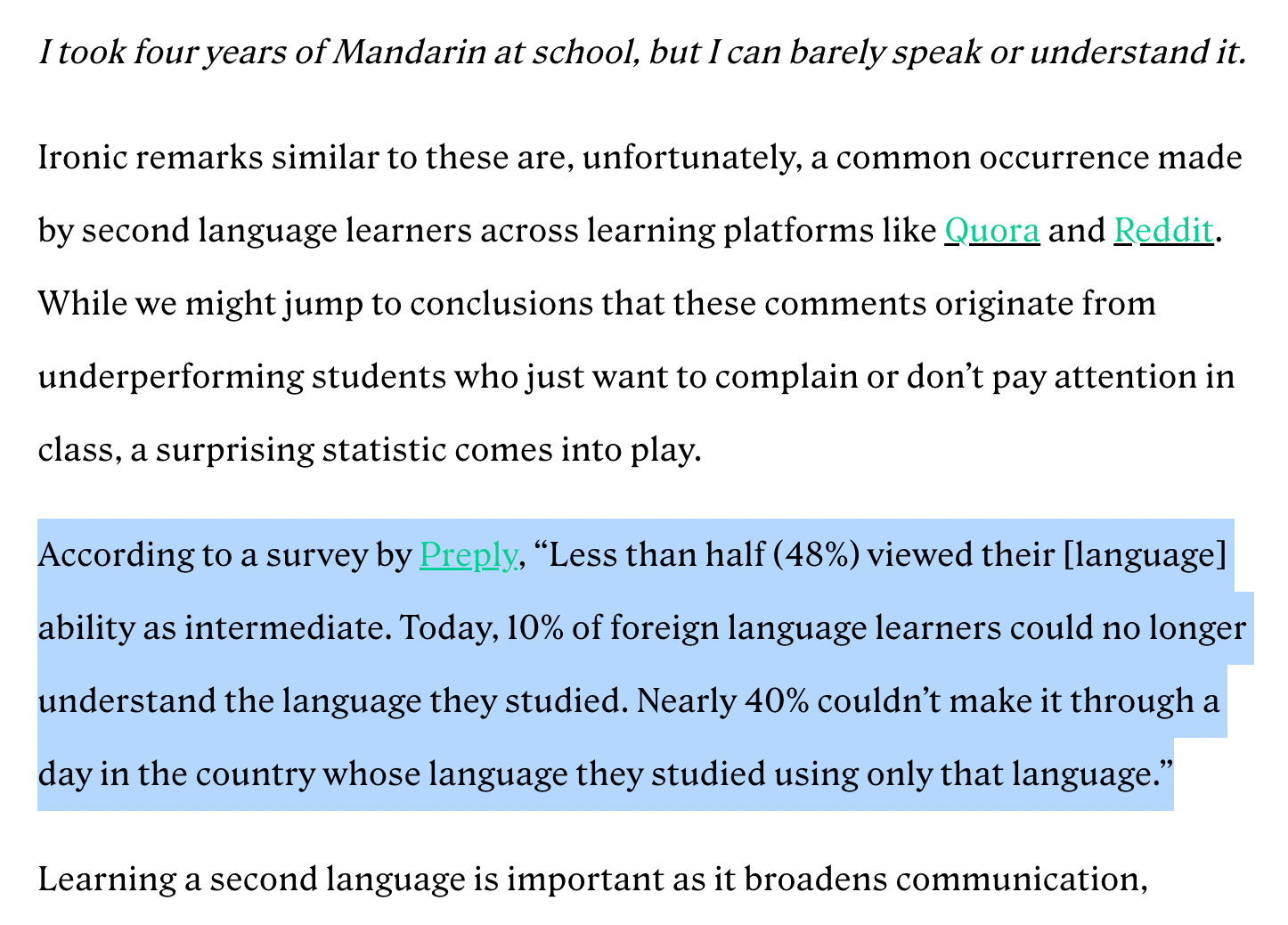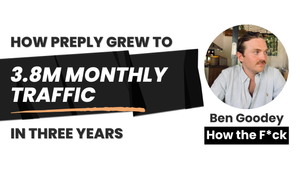Preply, the online language tutoring company, absolutely exploded in organic search traffic over the past three years.
Since 2012, the company has had some impressive stats:
- 55,000 tutors
- Millions of learners
- 400+ employees
- $120M+ funding raised
But it was only these last three years that saw Preply boom from 0.5M to 3.8M in monthly search traffic, according to Ahrefs.
So, what happened? What tactics did they deploy to get where they are? And how do we think it’s helping their wider revenue growth?
Let’s dive in.
Breaking Down Preply’s Content
The Preply site has around 60,000 web pages. You rarely see sites hit such high traffic numbers without so many pages.
These 60,000 pages break down into three rough buckets:
- The blog (a long-form content-led approach) - 1.9M traffic/month
- The forum (a UGC-led approach) - 0.85M traffic/month
- The services pages (a programmatic, product-led approach) - 1M traffic/month
Making a grand total (estimated) of ~3.8M monthly visitors.
1. Preply’s Blog Content Strategy - 1.9M traffic/month
Preply’s blog is the definition of a scaled international SEO campaign. There are 5,000 pages total, targeting search terms in a wide variety of languages.
As expected, the majority of traffic on the blog goes to top-of-funnel topics.
Most of these pages help answer the common questions of language learners (their target audience).
Keyword examples include:
- Indirect object pronouns spanish
- How is the Present Simple formed in English
- Basic Japanese words
I did some digging and found that about “2%” of Preply’s content was written by North Star Inbound, according to a case study on their site.
The case study shares some of the details on why they targeted keywords like this:
“We zeroed in on conversationalists and English as a second language (ESL) learners. Both these groups are trying to grasp language basics and both could benefit from affordable, one-on-one tutoring. Knowing this, we identified terms that would capture an audience in the early stage of their language-learning journey. These include topics on numbers, letters, sentence structure, and grammar rules. We also identified posts that weren’t ranking well, but had the chance to convert, and updated those.”
I imagine the other 98% of content came from a variety of freelancers and content operations specialists.
Preply operates in a space with a rare SEO opportunity—a truly vast amount of top-of-funnel search demand.
Not only is the addressable market large (all language learners), but every language has unique nuances and difficulties, multiplying the keyword opportunities by the number of languages out there.
This makes SEO an attractive brand-building opportunity for a fast-growing company with a big budget for content.
I did think that, at times, the topics strayed a little too top of funnel to warrant the investment.
Some topics I doubt include:
- How to address a letter
- Spanish nicknames
I’d question the point of targeting someone searching “how to address a letter” with a language tutoring service, even if “business English” is part of the service.
That being said, the majority of content is well-aligned with their target audience.
And I know from personal experience that things can slip through the net when scaling content so aggressively,
Middle of Funnel Blog Content
Preply’s blog also targets higher conversion potential keywords.
More MOFU keywords I found driving traffic, include:
- How to learn French - 16K search volume/month
- How to Learn Japanese - 21K search volume/month
- How to learn English step by step - 13K search volume/month
These readers are clearly looking for solutions to help them learn a language, meaning their alignment with Preply's online tutoring services is a snug fit.
I’d imagine a relatively solid percentage convert to customers.
The Blog UX | Four Cool Things
These four things made their blog design pop and I imagine help a lot with conversion rates.
1/ The authors of Preply’s blog posts are real tutors.
This gives a nice layer of expertise and subtly drives interest in what Preply sells.
2/ FAQs are baked into the template
Adding FAQs to content is a common SEO tactic.
Instead of shoving them at the bottom of the article like most do, Preply’s blog template adds them right above the footer, neatly at the bottom. (I've been implementing this design change with all my clients recently).
3/ On-brand custom graphics
Their blog content is peppered with custom graphics that elevate certain things the reader will find useful.
While this seems like a small element, it shows me that someone at Preply really cares about both the reader’s experience and ensuring the content *actually* improves the brand image.
These small things are a nuance most miss while scaling content—for me, they make the content that much more useful and trustable.
4/ There’s a dynamic CTA that changes based on the topic
As you scroll the blog post, a CTA drops down. The cool thing about this is that it’s relevant to the blog post topic:
2. Preply’s Expert Forum Strategy - 0.85M traffic/month
The Preply site has a forum where language learners can ask questions.
- Each country has its own forum
- The answers are given by Preply tutors
- The Q&A rank on Google
While their forum is by no means new, given the recent boom in forum-based SEO (see: Reddit and Quora’s recent jumps in traffic), having a community-driven forum is timely.
So, what's the organic growth mechanism here?
For one, the content is user-generated so the Preply team doesn’t have to create all the content themselves—a rare scalability option only those with large customer bases have available.
Secondly, tutors are incentivized to contribute and answer questions as it elevates their brand and services.
Note how it shows their name, educational background and "English Tutor" in bold:
These Q&A pages are being indexed by Google.
Examples of pages driving significant search traffic mostly include questions like “what does X mean?”:
These questions target very top-of-funnel keywords, but you can often see good engagement from language learners commenting on how useful it was.
At scale, the forum could both help engage and retain Preply’s existing customer base AND drive positive brand affinity and conversions from their target audience.
3. Preply’s Bottom of Funnel Playbook - 1M traffic/month
Preply has an almighty 48,000 pages that are not the blog or the forum.
From what I can see, the majority of these target bottom-of-funnel search queries, like:
- Online english teacher
- Japanese tutor
- Maths teacher (that’s right, turns our Preply is NOT just a language school but a complete tutoring service - targeting every subject and language out there!)
- Online spanish classes
A ton of keywords in this cluster follow the same "commercial research" pattern:
- [Subject] + [Tutor]
- And the longer tail [Online] + [Subject] + [Tutor]
Which is a perfect opportunity for programmatic SEO tactics—exactly what Preply does.
Much like Zoopla, Upwork, G2 and ClassPass, Preply has tapped into their database of tutors and autogenerated pages that match search terms.
Searching for "English Tutors"? From London? Here's all of ours.

This product-led approach to content matches the Preply tutor database to the search need.
Each list of tutors is supported by an FAQ section at the bottom of the page, which is a common strategy aimed at improving page relevance.
Preply had a very attractive SEO opportunity here.
Imagine this scenario:
- Preply tutors teach 50 languages
- Each keyword has 3 variations ("Spanish Tutor", "Spanish Classes", "Online Spanish Courses")
- Preply targets 20 countries (Hreflang)
- Within each country, they target 10 locations
The bottom-of-funnel page opportunity with this setup alone is: 50 x 3 x 20 x 10 = 30,000 pages.
The sheer volume of bottom-of-funnel search demand makes investing in SEO a powerful way to grow their business.
They also do local SEO | Winning but hmm?
As briefly mentioned, the Preply site also targets locations withing countries—aka, local SEO terms.
Part of the strategy seems to be including the locations across each country in the URL, for example https://preply.com/en/London-UK/english-tutors) adds the term London into the URL and the on-page content adapts slightly to present London-based tutors.
This seems a little bit hacky for a tutoring company that (to my best knowledge) only does online tutoring, not local in-person classes.
But you could argue that the searcher wanted an online class from a tutor based in London (🤷).
Besides, despite "doorway pages" being a long-standing "no-no" on Google's Guidelines, they are clearly still rankable and hard for Google to discern.
One positive worth noting is that these pages are full of relevant footer links.
Planning an internal linking strategy is key for successful SEO, and something that’s important not to forget when auto-generating 1,000s of pages.
The footer is a great place to share that internal link love with annoying users.
Preply’s Backlink Building Strategy
It’s hard to lift the hood on Preply’s backlink-building efforts without talking to the in-house team directly (I have reached out on LinkedIn but haven’t heard back yet).
However, I think landing pages like this one are telling. That is a commercial services page with 84 backlinks, a content type that would in my opinion be unlikely to receive natural backlinks.
Those 84 links are placed over Anchor Text which is also unlikely to happen organically.
So we should be able to assume that link building is a critical part of Preply’s SEO strategy.
The Head of SEO at Preply indicates on his LinkedIn that they have a link-building machine in place:
“In my first months, I've built the offsite/digital PR team and set up the machine to launch international content campaigns at scale, driven by SEO and amplified by other marketing channels. Together we’ve been able to build a fantastic engine that generates high-quality natural links across several markets and strengthens the brand image.” [edited slightly for readability]
The links tend to focus heavily on the homepage (and its language variants), which is common in a PR-based link strategy.
According to Ahrefs, Preply has added over 20,000 backlinks since 2021 and grown from DR 75 to 81 in that time.
Update (09 May '24)
I talked to Daniele Saccardi, Senior Digital PR Lead at Preply and he shared some really interesting insight into the Preply DPR setup.
Between in-house and agency, they have a multi-person team dedicated to DPR at Preply. Their quarterly target is in the thousands of DR 40 (minimum) backlinks.
"Biggest challenge is defo market approach/localisation, finding the right message we can scale from Turkey to anglosphere to Japan."
Here's an example campaign:
Preply earned a link from the LA Times here.

Which links to a piece of original research, a survey of over 1,000 people.
Another REALLY cool piece of work is this study into the rudest cities in each country. If you use the language drop-down, you see that they actually created this blog post and research for 7 countries—allowing them to secure even more relevant links from geo-local sites.

This shows how they're tackling the challenge of getting stories with global interest.
Thanks for reading this week’s crazy SEO success story.
Done some of your owning digging? Found something I missed?
Let me know what you’ve found in the comments below.
—Benny
Click here to become a premium subscriber and unlock more of these wild SEO case studies.
Need an SEO consultant and/or content production team? DM me on LinkedIn.


